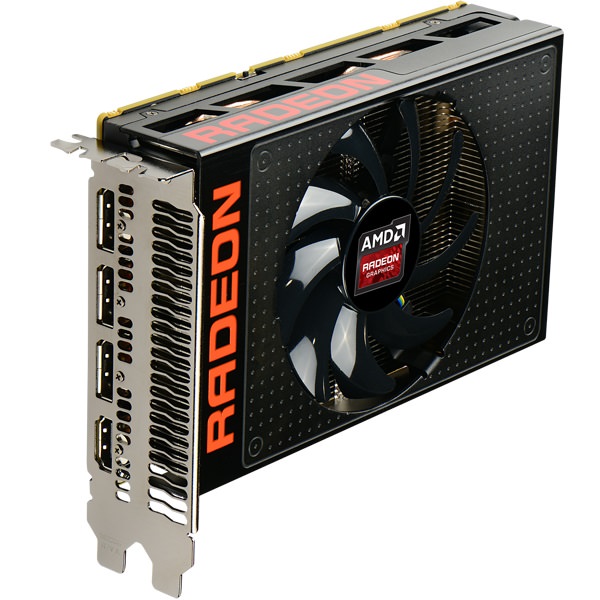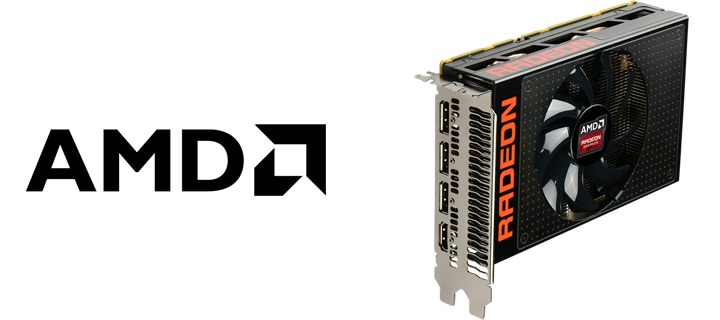AMD reinvents the small-form-factor PC with its third “Fiji”-based GPU featuring High-Bandwidth Memory (HBM) and next-generation DirectX® 12 gaming
AMD (NASDAQ: AMD) continues to push the boundaries of graphics card design, today announcing its category-creating AMD Radeon™ R9 Nano, the fastest Mini ITX graphics card ever , to enable 4K gaming in the living room through ultra-quiet, ultra-compact PC designs. First previewed to gamers around the world during the Electronic Entertainment Expo (E3) in Los Angeles in June 2015, the AMD Radeon R9 Nano graphics card is based on the graphics chip codenamed “Fiji”, and is the third “Fiji”-based product to launch this summer alongside the AMD Radeon™ R9 Fury and R9 Fury X graphics cards. The AMD Radeon™ R9 Fury graphics family, based on the “Fiji” chip, marks a turning point in PC gaming with the implementation of High-Bandwidth Memory (HBM) to deliver extreme energy efficiency and performance for ultra-high resolutions, unparalleled VR experiences, smoother gameplay, with the Radeon R9 Nano revolutionizing form-factors for enthusiasts everywhere.
With 30 percent more performance and 30 percent lower power than the previous generation AMD Radeon™ R9 290X card, the 175W AMD Radeon R9 Nano is the world’s most power efficient Mini ITX enthusiast graphics card. The six-inch long, air-cooled board represents a new class of graphics card, enabling gamers, PC modders, and system integrators to build compact, unique, ultra-small form factors that have never before been possible, opening the door to new, sleek PC designs that are no bigger than a home DVR or videogame console, and look every bit in place beside them.
“With the Radeon™ R9 Nano graphics card, AMD is enabling 4K class gaming in your living room in an exceptionally quiet, ultra-small design built to excel in today’s games and on the latest APIs like DirectX® 12 and Vulkan™. There simply is nothing else like it,” said Matt Skynner, corporate VP and general manager, Product, Computing and Graphics Business Unit at AMD. “Our Radeon™ graphics line-up is ushering in a new era of PC gaming delivering remarkable performance, unmatched GPU designs and groundbreaking technologies. Today is a revolutionary moment for PC gaming, and we are proud to add this distinct product to our well-rounded AMD Radeon R9 graphics lineup.”

The AMD Radeon R9 line of graphics cards offers a spectrum of products ranging in price from $199 – $649 SEP . Delivering stunningly powerful graphics for unparalleled 4K gaming experiences in their class, the AMD Radeon R9 Series meets virtually every need and budget for anyone who demands a premium gaming experience.
| Features | |
| Virtual Super Resolution (VSR) | Yes |
| Frame Rate Target Control (FRTC) | Yes |
| High-Bandwidth Memory (HBM) | Yes |
| AMD FreeSyncTM Technology | Yes |
| AMD LiquidVR™ Technology | Yes |
| 4K Resolution Support | Yes |
| AMD Eyefinity Support | Yes |
| AMD CrossFire™ Support | Yes |
| Specifications | |
| Process | 28nm |
| Stream Processors | 4096 |
| Compute Units[i] | 64 |
| Engine Clock | Up to 1000 MHz |
| Compute Performance | 8.19 TFLOPS |
| Texture Units | 256 |
| Texture Fill-Rate | 256 GT/s |
| ROPs | 64 |
| Pixel Fill-Rate | 64 GP/s |
| Z/Stencil | 256 |
| Memory Configuration | 4GB HBM |
| Memory Interface | 4096-bit HBM |
| Memory Speed / Data Rate | 500MHz / 1.0Gbps |
| Memory Bandwidth | 512 GB/s |
| Power Connectors | 1 x 8-pin |
| Typical Board Power | 175 W |
| PCIe® Standard | PCI-E 3.0 |
| API Support | DirectX® 12, Vulkan™, OpenGL® 4.5, Mantle |
The SEP of the AMD Radeon™ R9 Nano graphics card will be $649 USD4 and is planned to be available in stores and at participating retailers the week of September 7, 2015.
Supporting Resources
Check out the AMD Radeon R9 graphics page for more details:
Become a fan of AMD Gaming on Facebook
Engage with us on Twitter @AMDGaming
Engage with us on Twitter @AMDRadeon
Become a fan of AMD on Facebook
More information on AMD Investor Relations
Check out our Exclusive Nano Twitch stream on 9/3
Liked this post? Follow SwirlingOverCoffee on Facebook.
About AMD
For more than 45 years AMD has driven innovation in high-performance computing, graphics, and visualization technologies ― the building blocks for gaming, immersive platforms, and the datacenter. Hundreds of millions of consumers, leading Fortune 500 businesses, and cutting-edge scientific research facilities around the world rely on AMD technology daily to improve how they live, work, and play. AMD employees around the world are focused on building great products that push the boundaries of what is possible. For more information about how AMD is enabling today and inspiring tomorrow, visit the AMD (NASDAQ: AMD) website, blog, Facebook and Twitter pages.
AMD, the AMD Arrow logo, Catalyst, CrossFire, FreeSync, LiquidVR, Radeon and combinations thereof are trademarks of Advanced Micro Devices, Inc. Other product names used in this publication are for identification purposes only and may be trademarks of their respective companies. Microsoft, DirectX and Windows are registered trademarks of Microsoft Corporation in the US and other jurisdictions. PCIe is a registered trademark of PCI-SIG Corporation.
1Testing conducted by AMD Engineering on optimized AMD reference systems. PC manufacturers may vary configurations yielding different results. 3DMark FireStrike at 3840×2180, Ultra preset, 0xMSAA, 0XAF is used to simulate GPU performance; the Radeon™ R9 Nano on the system using the Intel® Core™ i7-5960X 3.0GHz processor, 16GB (4x4GB) DDR4 2666 MHz memory, Windows 10 64-bit, and AMD Catalyst Driver 15.201 scored 3411 while the Sapphire Radeon™ R9 380 Mini ITX on the same system and AMD Catalyst Driver 15.20 scored 1551, the GTX 970 Mini ITX on the same system and GeForce Driver 355.60 WHQL scored 2593, the GTX 960 Mini ITX on the same system and GeForce Driver scored 1297 GRDT-73
2Testing conducted by AMD Engineering on optimized AMD reference systems. PC manufacturers may vary configurations yielding different results. Far Cry 4 at 3840×2180, Ultra High preset, SMAA, 0XAF is used to simulate GPU performance; the Radeon™ R9 Nano on the system using the Intel® Core™ i7-5960X 3.0GHz processor, 16GB (4x4GB) DDR4 2666 MHz memory, Windows 10 64-bit, and AMD Catalyst Driver 15.201 scored 37.966 fps while the Radeon™ R9 290X on the same system and AMD Catalyst Driver 15.20 scored 27.207 fps GRDT-69
3Based on the product design, the Radeon™ R9 Nano is defined with a typical board power of 175W while the Radeon™ R9 290X is defined with a typical board power of 250W GRDT-76
4As of 8/27/2015
5Discrete AMD Radeon™ and FirePro™ GPUs based on the Graphics Core Next architecture consist of multiple discrete execution engines known as a Compute Unit (“CU”). Each CU contains 64 shaders (“Stream Processors”) working in unison.


